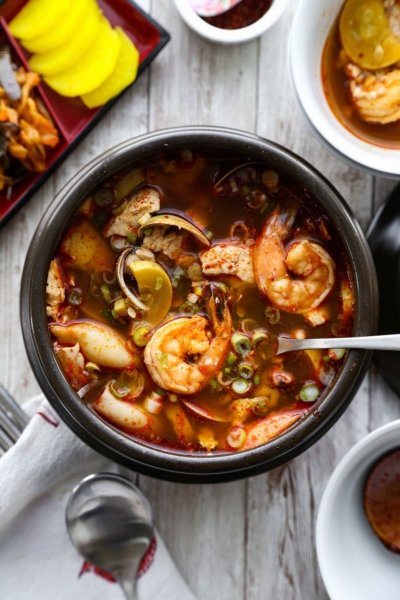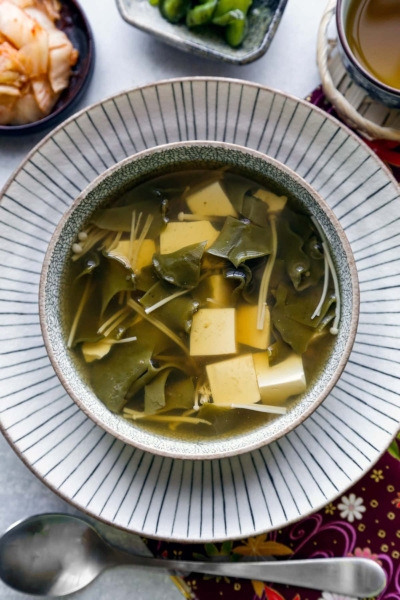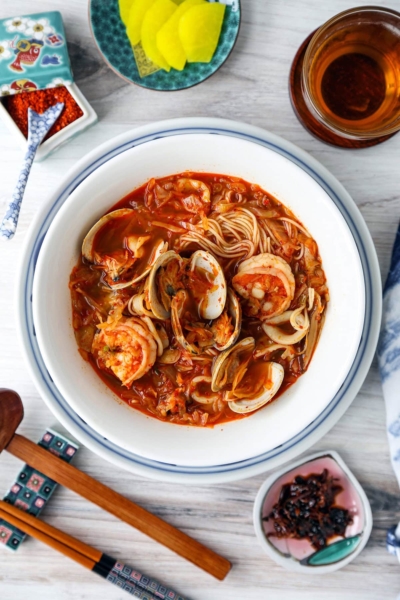Making dolsot bibimbap in a skillet is so easy! This recipe uses cabbage kimchi to add salty, savory, and spicy notes to the dish. But feel free to add your own spin to it. Ready in 25 minutes from start to finish (including prep time!).

Table of contents
What is Dolsot Bibimbap
Dolsot bibimbap is a Korean mixed rice dish served in a screaming hot stone pot. Common bibimbap ingredient additions are veggies like mushrooms, zucchini, carrots, fernbrake, kimchi and cucumber – and proteins like beef, octopus and eggs.
The stone bowl serves two purposes.
- Once the bowl has been heated throughout, it is brushed with sesame oil. After the rice is placed in the bowl, it begins to sizzle, brown and get crispy. The texture and flavors are incredible!
- Also, since the stone bowl is so hot, it keeps the overall dish hot as you eat it. And your dolsot bibimbap won’t cool down as quickly as it would served in more common tableware.
What’s the Difference Between Bibimbap and Dolsot Bibimbap
- Bibimbap is the rice recipe itself – featuring short grain rice mixed with veggies, meat or seafood and condiments.
- Dolsot refers to the sizzling hot stone bowl.
Therefore, bibimbap can be served on any type of plate or bowl – whether it’s ceramic or plastic. But if it’s prepared and served in the hot stone bowl (dolsot), then it’s dolsot bibimbap.
Luckily, I’ve got a simple technique for getting the crispy rice from a dolsot bibimbap without needing to run out and buy a stone pot. Because you can just use a skillet to get that trademark crispy rice!

Dolsot Bibimbap Ingredients
- Cooking Oil: Use a neutral oil like vegetable oil or grapeseed oil. Steer clear of olive oil for this recipe (as it’s got too much natural flavor).
- Shiitake Mushrooms and Zucchini: Shiitakes have a ton of umami and a meaty chew to them. And zucchini does a great job of soaking up the assertive flavors of the soy sauce, sesame oil and kimchi.
- Bean Sprouts and Baby Spinach: Bean sprouts impart a wonderful wilted crunchy texture that plays nice with the crispy edges of the rice. And baby spinach introduces pops of verdant color. Some people like adding carrots sliced matchstick thin. If that’s you, feel free to add them too.
- Cooked Rice: I like using short grain Japanese rice. It’s common to see true short-grain rice at the grocery store sold as sushi rice. The secret is using leftover cooked rice that has had time to dry out in the refrigerator overnight. That way, when you introduce the liquid seasonings in the skillet, the rice grains can take on the added moisture without becoming gloppy. Here’s a tutorial on how to cook Japanese rice on the stove top or in a rice cooker. And you can grab short grain rice on Amazon.
- Cabbage Kimchi: This fermented Korean cabbage is funky, salty and bright. While the spice level can run the gamut from mild to volcanic, most kimchi is fairly tame when it comes to actual heat.
- Soy Sauce and Sesame Oil: You’ll get a blast of umami from soy sauce – and a toasted nuttiness from a couple teaspoons of sesame oil.
Finishing Touches
- Eggs: Many dolsot bibimbap recipes call for a raw egg yolk served on top right at the end. And that’s delicious! However, I prefer a fried egg served sunny side up with a runny yolk. Try to buy eggs that are Certified Humane. It’s way easier than you might think these days. Here’s how to decode the egg carton.
- Salt and Pepper: These are seasonings you can use (or omit) based on your personal taste. And you’re not stuck with black pepper only. Gochugaru (smoky dried Korean chili pepper) works as well.
- Bibimbap Sauce: This condiment adds a little extra fiery zing (more on this Korean sauce in a sec).
- Optional Toppings: Many people enjoy a sprinkle of sesame seeds or a bit of chopped green onion (scallions).

How to Make Bibimbap in a Skillet
- Gather all of your cooking tools and ingredients.
- Get a large skillet, frying pan or flat bottom wok on the stove over medium high heat and add the vegetable oil. Once the oil is hot, gently (and carefully!) swirl it so that it covers the cooking surface of the skillet evenly.
- Add your mushrooms and fry for 2 minutes.
- Next, add the sliced zucchini and pan fry for 2 minutes.
- Then add the chopped spinach and bean sprouts to the skillet and cook for 1 minute.
- Break up your leftover rice with a rice paddle or spatula (or even your hands). You want to make sure there aren’t any large clumps. Then mix the rice in with the vegetables and cook for an additional 2 minutes.
- Add your kimchi, soy sauce and sesame oil to the skillet at this time and gently toss or stir the ingredients so that the rice is evenly coated – and mixed in with the veggies.
- Next, spread the rice mixture out so that it evenly covers the cooking surface of your skillet. Use the entire surface of the pan so as much rice is in contact with the heat as possible. Continue cooking for 2 to 3 minutes without touching it – until the edges of the rice start to look a little crispy.
- At this point, turn the heat off and set the skillet aside (with the food still inside!).
- In another pan or skillet over medium heat, add a little cooking oil and fry your eggs for a couple of minutes. I like sunny side up eggs with a runny yolk, but you do you.
- Finally, divide the bibimbap into four servings and top each with an egg. Serve with bibimbap sauce.

Bibimbap Sauce
Think of Korean bibimbap sauce as a spicy, sweet, nutty and savory condiment you can serve alongside dolsot bibimbap. It’s a mixture of gochujang sauce, garlic, sesame oil, rice vinegar, a tbsp of sugar (and / or a couple tablespoons of honey) and a pinch of salt.
- I’ve got an easy, foolproof recipe for the best homemade bibimbap sauce here.
And keep in mind, much like the ubiquitous ketchup served with French fries, you can use a little or a lot – based on your personal preferences.

What to Serve With Bibimbap
Dolsot bibimbap is one of those humble, hearty, substantive kitchen sink meals. And since there’s so much going on in terms of ingredients and flavors, I tend to think more in terms of small, appetizer portion sides. These small Korean dishes are called banchan. Here are a few favorites.
And check out these other popular and easy Korean recipes
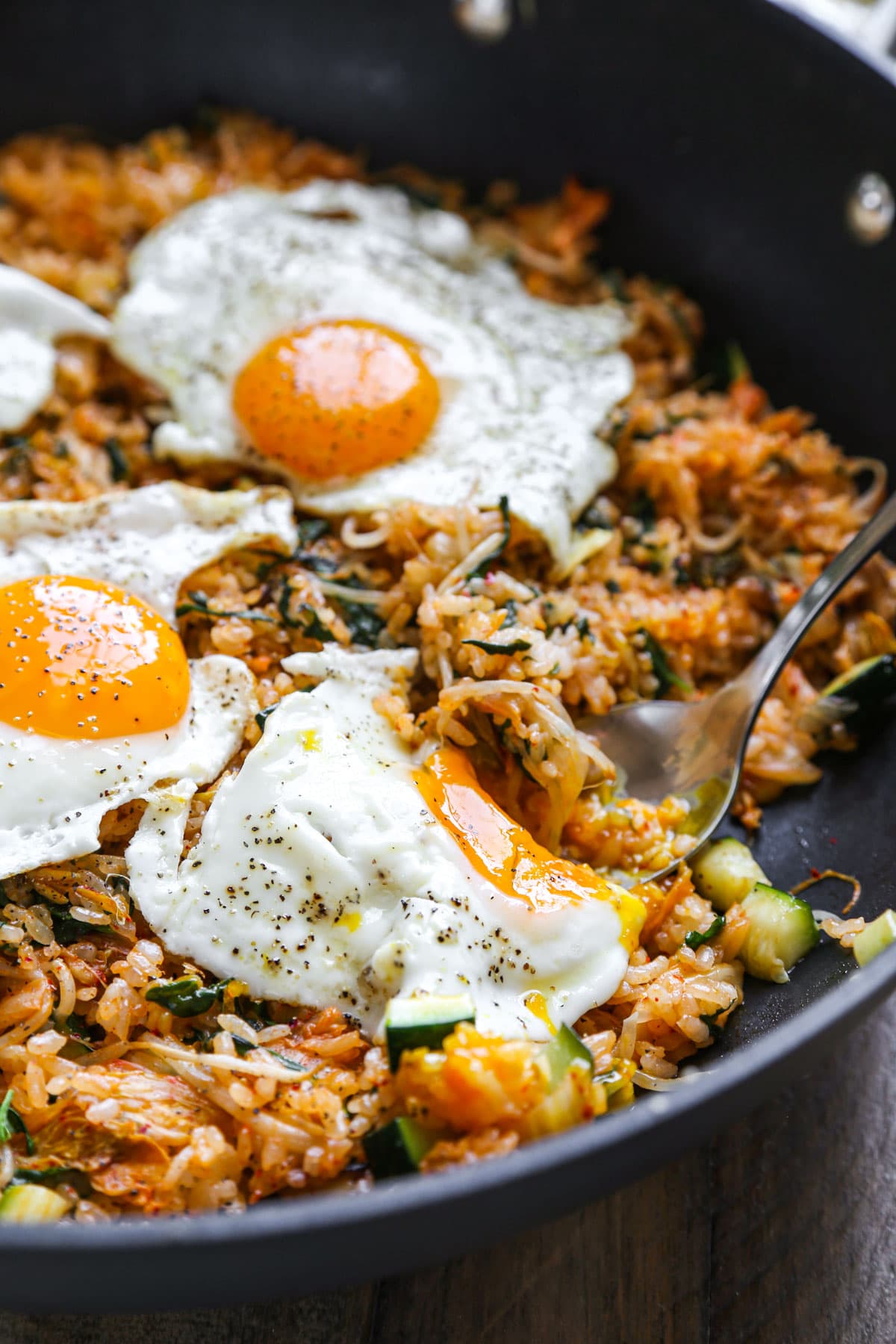
How to Store Leftovers
Leftover bibimbap can be stored in an airtight food storage container in the refrigerator for 1 to 2 days.
- However leftovers should be stored without the eggs.
- Heat up leftovers in the microwave – or better yet, reheat in a hot skillet with a little oil.

Did you like this skillet dolsot bibimbap recipe? Are there changes you made that you would like to share? Share your tips and recommendations in the comments section below!
Print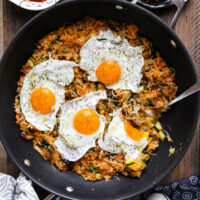
Skillet Dolsot Bibimbap
- Prep Time: 15 minutes
- Cook Time: 10 minutes
- Total Time: 25 minutes
- Yield: 4 people 1x
- Category: Rice
- Method: Stir frying
- Cuisine: Korean
- Diet: Vegetarian
Description
This skillet dolsot bibimbap uses cabbage kimchi to add salty, savory, and spicy notes to the dish. But feel free to add your own spin to it!
Ingredients
- 1 tablespoon vegetable or grapeseed oil
- 6 shiitake mushrooms, chopped
- 1 small zucchini, diced or sliced into thin strips
- 1 cup baby spinach, chopped
- 2 cups bean sprouts
- 4 cups day old (cold or room temperature), cooked short grain rice (also referred to as sushi rice)
- 200g cabbage kimchi (baechu kimchi), drained and chopped
- 2 teaspoons soy sauce
- 2 teaspoons sesame oil
- 4 eggs
- Salt and pepper, to taste
Instructions
- In a large deep skillet over medium high heat, add the vegetable oil.
- When the oil is hot, swirl it around to coat the surface of the skillet evenly. Add the mushrooms and pan fry for 2 minutes.
- Add the zucchini and pan fry for 2 minutes.
- Add the spinach and bean sprouts and pan fry for 1 minute.
- Add the rice and gently break it up using a rice paddle or spatula. Mix it in with the vegetables and cook for 2 minutes.
- Add the kimchi, soy sauce, and sesame oil and gently toss the ingredients around to coat the rice evenly.
- Spread the rice so it covers the surface of the skillet and looks like a flat pancake. Continue cooking for 2 to 3 minutes without touching it, until the edges of the rice look a little crispy.
- Turn the heat off and set aside.
In another skillet, add a little oil and fry the eggs for a couple of minutes (sunny side up).
Divide the bibimbap into 4 servings and top each serving with an egg. Serve with bibimbap sauce.
Notes
Storage: Save the eggs separately from the bibimbap, on a plate or a container. They will keep for about 2 days in the fridge. Save the leftover bibimbap in a storage container and refrigerate for up to 4 days.
Nutrition
- Serving Size: 1 serving
- Calories: 400
- Sugar: 3.7g
- Sodium: 404mg
- Fat: 11.3g
- Saturated Fat: 4.8g
- Unsaturated Fat: 2.2g
- Trans Fat: 0g
- Carbohydrates: 60.5g
- Fiber: 2.7g
- Protein: 14g
- Cholesterol: 186mg

